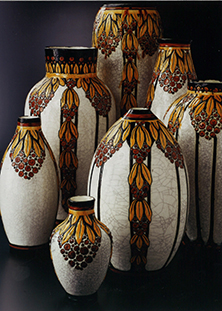A programme specific to Art Nouveau
With Art Nouveau (1890-1910) came beauty made accessible to a wider public. Charles Catteau certainly shared this idea. The first objective of art should be to make everyday life more beautiful, everywhere and for everyone.
Industrialisation and Art Deco
Unfortunately, the cost of materials and of making objects often precludes real democratisation. Yet, a quarter of a century later, thanks to a certain degree of mechanisation generated by new industrial techniques, this objective gradually comes closer to realisation. Standardisation, which accompanied the new methods, enabled production to be faster and more diversified, resulting in lower prices that were accessible to the general public.
This development nevertheless had a certain drawback: projects had to avoid being too original in the hope that they would appeal to a ‘typical’ buyer. The creativity of the artist and the craftsman had to give way to profitability, whilst the industrial aesthetic replaced the art of the artisan.
It was against this background that Art Deco made it appearance (1920-1939). This was a style that reached across several disciplines and whose primary objective was to appeal to the general public, thanks to mass production. Style was now in the service of industry and art became a means of renewing production and widening one’s clientele. Objects were simple, created with great technical skill and demonstrated real know-how.



Catteau’s social art
In his function as head of studio at Boch Frères, Catteau managed to give free reign to his creative liberty, whilst nevertheless remaining within commercial constraints. He succeeded in developing a very particular style that became recognised worldwide and bore witness to his time. Catteau thought of himself as a creative artist in the service of industry.
The lessons he gave at the professional school in La Louvière and the role he played in Les Amis de l’Art, the association he founded with a group of friends and of which he was president, offered him the opportunity to put into practice this founding principle. In fact, the aim of the group was to familiarise all sections of the population with art and professional schools undertook to train qualified craftsmen to work in the world of business.